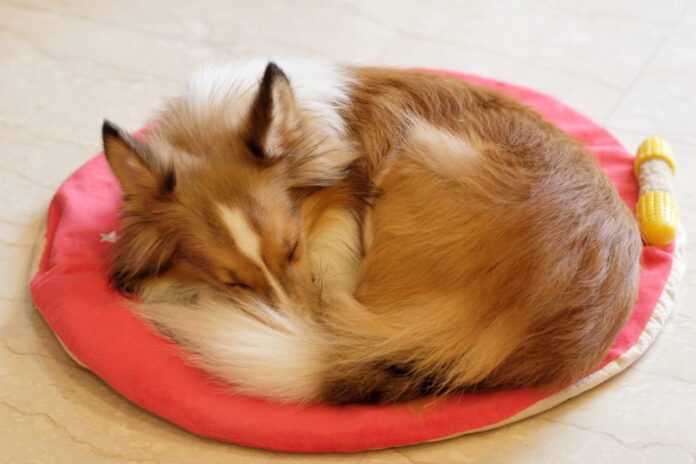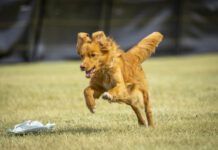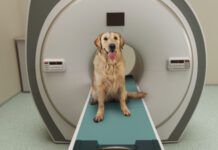Some people say dogs circle three times before lying down. Others say they only do it once. And still others say they don’t do it at all. So, what’s the truth about whether dogs turn in a circle before they lie down? And if they do, why do they do it?
Even renowned scientists and dog behaviorists don’t know for sure. Oddly enough, even though this is a very common canine behavior, there have been almost no formal research studies on the phenomenon. (There is, however, significant research on excessive and prolonged circling that’s related to canine obsessive-compulsive disorder and neurological issues. More on that later.)
Of course, none of this has stopped people from speculating on the reasons for this behavior. One theory is that it’s a holdover from the domestic dog’s wolf ancestors, who needed to check their surroundings for threats before settling down to sleep. Another idea is that dogs circle to chase away any pests that might be hiding in the weeds that would disturb their sleep. Others believe that it’s because dogs need to flatten tall grass and underbrush to make a comfortable “nest” for themselves and their pups.
Let’s take a look at each of these theories.
Looking for Dangers
Dr. Leslie Irvine, who researches the roles of animals in society and is the author of If You Tame Me: Understanding Our Connection With Animals, relates it to instinctive wolf behavior. “In the wild, the circling would flatten grasses or snow and would drive out any snakes or large insects.” She also speculates that circling and flattening the area would have left a visible sign to other wolves that the territory was already claimed.
This circling action also may have enabled wolves to position themselves with their noses to the wind in order to quickly pick up on a scent that signaled a potential attack. One other thought is that ancient dogs could have circled to look around and make sure all their pack members were accounted for before going to sleep.
Getting Comfortable
One reason the dog’s wild ancestors circled may have been to simply create a relatively flat, circular spot to lie in. In tall grass, circling could enable the wolf to pat down the area and scoop out any rocks or other uncomfortable objects with their paws to make a soft spot. Today, of course, most of our companion dogs have soft dog beds or blankets to lie on . . . but like so many instinctual behaviors, the impulse to circle remains.
The notion that dogs circle in order to get comfortable is supported by other animal experts, who are skeptical of the notion that scouting for threats and predators is the reason for this circling behavior. Behaviorist and veterinarian Dr. Christopher Pachel believes the behavior is most likely associated with preparing the ground for a comfortable resting spot. He adds that there could also be what he calls an “unwinding” aspect to circling, which dogs often display when they’re shifting from an awake state to a resting one.
This “nesting” instinct is supported by an experiment run by renowned dog behaviorist Dr. Stanley Coren. He discovered that when dogs are presented with a soft, uneven surface, they are much more likely to turn in circles before they lie down, and often scratch or paw at the material to arrange it to their liking. When are given a flat, smooth surface, far fewer dogs exhibited the circling behavior.
Controlling Body Temperature
After circling, many dogs choose to lie curled up rather than stretched out. This position helps them regulate their body temperatures and conserve heat around the core of their bodies, especially in cold climates. Many Huskies, for instance, curl into a ball to sleep in the snow to prevent heat from escaping; they usually tuck their noses between their hind legs and tails, and cover their faces with their bushy tails, which protects their noses from the cold and allows them to breathe in warm air. At the same time, other pack members will gather together in a tight circle to effectively share body heat.
Aligning with the Earth’s Magnetic Field
Chances are, this is something you didn’t realize (I certainly didn’t!), but studies have proven that under calm magnetic field conditions, at least 30 percent of dogs prefer to eliminate with their bodies aligned along the North–South axis. Why dogs choose to align with the earth’s geomagnetic field when eliminating remains a mystery: do they do it consciously because they can actually sense the magnetic field, or do they simply feel better or more comfortable when aligned to it? It has been posited that the same could be true of dogs’ circling behavior: a way to position their bodies in relation to the earth’s magnetic field. In fact, at certain times several species of mammals spontaneously align themselves with respect to the magnetic field lines, including grazing and resting cattle, roe deer and red deer, and hunting red foxes.
When Circling is a Problem
Usually, we find circling behavior simply curious and amusing, but there are times when circling can indicate serious problems. If you believe your dog is circling excessively or the behavior appears suddenly, becomes more pronounced, or shows up alongside other symptoms, consult a veterinarian.
A dog persistently walking in circles often signals a forebrain dysfunction, which can include brain tumor, stroke, brain inflammation such as encephalitis, or hydrocephalus (brain swelling from a buildup of cerebrospinal fluid).
Another cause of excessive circling can be canine peripheral vestibular disease, caused by lesions in the middle and inner ear that affect balance and can result in persistent circling. It can stem from ear infections, head trauma, tumors, or it may be idiopathic (having no identifiable cause). The idiopathic form is especially common in older dogs, hence the antiquated name, “old dog vestibular syndrome.” Today, however, we understand that this disease can occur at any age, so that term has been replaced by canine idiopathic vestibular disease.
Orthopedic disorders like arthritis, spinal cord, or back problems can also underlie excessive circling, since dogs in pain will often circle to find a more comfortable position.
Persistent circling has also been seen in dogs with obsessive-compulsive disorder, which is characterized by repetitive, exaggerated behaviors which interfere with normal, activities and functioning. The same is true for dogs with with Cognitive Dysfunction Syndrome (CDS). As with human dementia, this is a condition related to the aging of the brain, and is most often seen in dogs nine years old and older. That being said, it’s important not to assume that your older dog’s behavioral changes such as repetitive circling are a result of CDS, since many dementia symptoms can be caused by other medical issues.
In the end, if your pup circles once, twice, or even three times before settling down for a nap, there’s no need to worry. We may not be able to explain exactly why they do it, but there’s no doubt that it’s very normal and predictable canine behavior.






